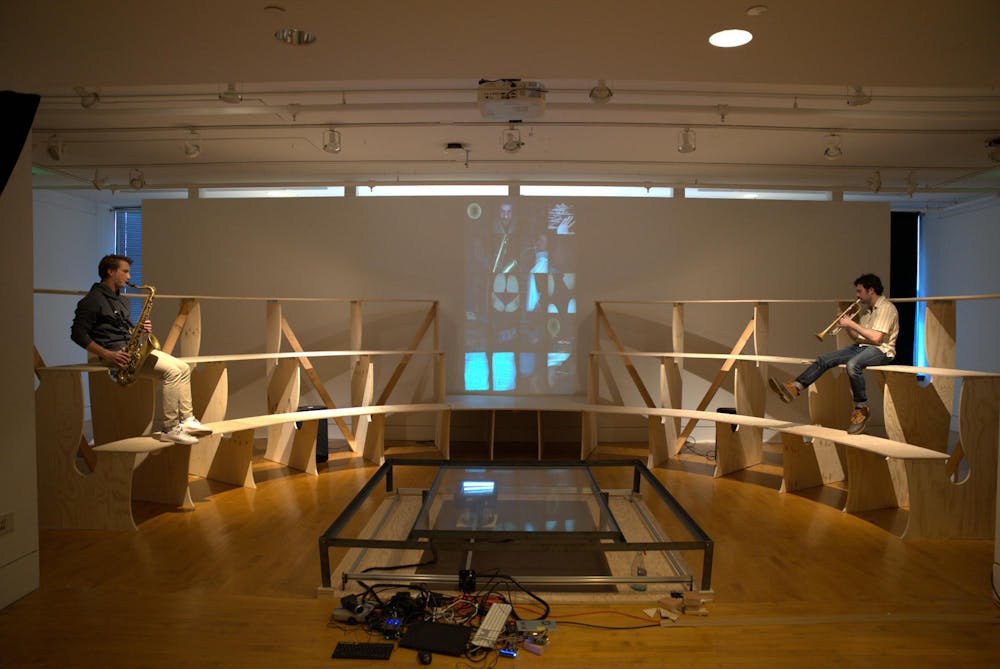“Do you have an iPhone? The idea behind the question marks was when you haven’t updated your phone, and the emojis won’t show up,” Petr Karpov ’24 said as I sat on the human-sized scanner’s glass pane, waiting to be scanned. I watched as a normal-sized scanner roved underneath the glass. The smaller scanner systematically makes its way across the whole pane, and a computer program then puts these small scans together to piece together one large image of whatever is sitting on the glass—in this case, me.
Karpov continues to explain the title of the senior thesis he developed in partnership with Luke Shannon ’24. “The question mark emojis are what Luke wanted to call the scanning part of it. The Commons is this thing,” he said gesturing at the wooden, bleacher-like seating around us. At first glance, the exhibit as a whole resembled a mini concert venue, with its curved, wooden benches arching around a life-sized black scanner positioned to resemble a small stage. A gap in the middle of the wood seating is just large enough to frame projections of recent scans, one of which is now of me. Karpov explains that the similarity to a concert venue was his and Shannon’s intention, as they plan to put on small concerts and parties in the space. “So put together, we have The Commons presents ⍰⍰⍰. It can also present other stuff, like The Commons presents Old Nassoul.”
Every spring, seniors in Princeton’s visual arts program create and present their own exhibitions, a creative analog to a thesis, to show the work they’ve done in the department. This year was the first in which seniors could put on collaborative exhibitions. Karpov and Shannon chose to put on an exhibition together called The Commons presents ⍰⍰⍰. The exhibition is located in the Lucas Gallery at 185 Nassau St., home to the visual arts program, and is open from March 25 to April 5. Karpov and Shannon are in the gallery from 8 p.m. to 10 p.m. every day, manning and guiding viewers through their creation.
Though they have different majors with differing artistic focuses, Karpov and Shannon wanted to create a truly collaborative exhibition rather than one that resembled two distinct, side-by-side exhibitions. Indeed, the exhibition feels like one, cohesive space. Karpov, an architecture major, created the wooden “Commons,” while Shannon, a computer science major, put the scanner together. Even though the exhibit presented as one complete work, Karpov’s and Shannon’s individual contributions are evident upon closer inspection.
What gives the exhibition both its charm and its ingenuity is that Karpov and Shannon not only celebrate their own individual artistic visions, but they actively encourage visitors to make their own mark on the space. With the press of a button, visitors to the exhibition can easily create their own scans. The most recent scans are projected onto the wall behind The Commons, such that visitors’ creations become seamlessly integrated into the installation. The Commons was purposefully made of unfinished, unpainted wood to act as a blank canvas, according to Karpov. They envision The Commons to be a kind of physical manifestation of memory, capturing and displaying the marks visitors unintentionally make as they sit, dance, and otherwise interact with the wood. Even the wiring of the scanner is strategically exposed, such that visitors can easily trace the scanning system’s electrical internal components.
In pamphlets placed at the entrance, visitors have even more access into how the exhibition was put together and executed. The pamphlet, drawn simply in black lines on a white background, lays out the modular components that make up The Commons and also has a flowchart to guide viewers through the scanner’s technical workings.
“We really wanted to let people know exactly what processes are making it happen,” Karpov explained.
Karpov and Shannon still have plans for their exhibition to change and grow throughout the duration of its installation. They plan to print the scans made by visitors, hanging them up on the walls to further highlight the work of exhibition attendees, cementing them and their participation as a part of the exhibition. Shannon wants to make the scanner motion-sensor activated, so that any curious people investigating the scanner automatically start and make a scan.

In the exhibition’s open invitations to visitors, Karpov and Shannon have crafted their senior thesis into a tribute to all those who visit their installation. It is a fun and worthwhile visit, regardless of one’s attitude towards what they consider traditional or conventional art. Their art is not just something to look at, but something to interact with and be a part of. Due to the exhibit’s continual evolution, both in its artist-driven design and its community-driven markings, it’s one to return to again and again.
Audrey Zeng is a freshman contributing writer for the Prospect. She can be reached at audrey.zeng@princeton.edu









